Vietnam Combat Artists Program
| U.S. Army Vietnam Combat Artists Program | |
|---|---|
 LOOKING DOWN THE TRAIL Watercolor James Pollock, CAT IV, 1967 Courtesy of the National Museum of the U.S. Army | |
| Active | (June 1966–1970) |
| Country | United States of America |
| Allegiance | United States of America |
| Branch | United States Army |
In June 1966, the Army Vietnam Combat Artists Program was established as part of the United States Army Art Program, utilizing teams of soldier-artists to make pictorial records of U.S. Army activities in the course of the Vietnam War for the annals of military history. The concept of the Vietnam Combat Art Program had its roots in WW II when the U.S. Congress authorized the Army to use soldier-artists to record military operations in 1944.[1]
During the Vietnam Era, the U.S. Army Chief of Military History asked Marian McNaughton, then Curator for the Army Art Collection, to develop a plan for a Vietnam soldier art program. The result was the creation in 1966 of the U. S. Army Vietnam Combat Art Program under the direction of the Office of Chief of Military History and McNaughton's office. Her plan included involving the U.S. Army Arts and Crafts Program, then headed by Eugenia Nowlin. McNaughton's office relied on Nowlin and her cadre of local Army Arts and Crafts directors to solicit applications from soldiers, which were forwarded to McNaughton's office at the U.S. Army Center of Military History, where selection and team assignments were made.[2] The U.S. Army provided logistics support as the teams of artists were sent to Vietnam and then to Hawaii.[3]
Artists interested in joining the program were asked to submit applications through the Army Arts and Crafts Program facilities nearest their unit.[4] Applications were to contain samples of drawings, photographs of paintings and a resume. Selections were made by a committee composed of designated representatives from the Office, Chief of Military History and the Adjutant General's Office. Supervised by Army Art Curator Marian McNaughton.[2] The program was the joint responsibility of the Office, Chief of Military History, and the Adjutant General's Office with support from the Office, Chief of information.[3]
History
Nine Combat Artist Teams (CATs) operated in Vietnam.[5] Typically, each team consisted of five soldier artists who spent 60 days of temporary duty (TDY) in Vietnam gathering information and making preliminary sketches of U.S. Army related activities. The teams then transferred to Hawaii for an additional 75 days to finish their work. Artists were given artistic freedom and encouraged to depict subjects in their own individual styles. Art created by soldier artists became a part of the U.S. Army Art Collection maintained by the U.S. Army Center of Military History (CMH), Washington, D.C.[3]
On 17 March 1969, due to the widespread interest shown by soldier artists and the impact of their work throughout the Army, the official name was changed from the VIETNAM COMBAT ART PROGRAM to the ARMY ARTIST PROGRAM. Coverage was expanded to include portraying the U.S. Army worldwide.[6]
U.S. Army soldier artist participants

List of U.S. Army Vietnam Combat Artist Team (CAT) members and supervisors from 15 August 1966 – 14 January 1970. (Cities listed reflect information on original applications which are currently in archives of U.S. Army Center of Military History).
- CAT I, 15 Aug - 15 Dec 1966, Roger A. Blum (Stillwell, KS), Robert C. Knight (Newark, NJ), Ronald E. Pepin (East Hartford, CT), Paul Rickert (Philadelphia, PA), Felix R. Sanchez (Fort Madison, IA), John O. Wehrle (Dallas, TX), and supervisor, Frank M. Sherman.
- CAT II, 15 Oct 1966 – 15 Feb 1967, Augustine G. Acuna (Monterey, CA), Alexander A. Bogdanovich (Chicago, IL), Theodore E. Drendel (Naperville, IL), David M. Lavender (Houston, TX), Gary W. Porter (El Cajon, CA), and supervisor, Carolyn M. O'Brien.
- CAT III, 16 Feb - 17 June 1967, Michael R. Crook (Sierra Madre, CA), Dennis O. McGee (Castro Valley, CA), Robert T. Myers (White Sands Missile Range, NM), Kenneth J. Scowcroft (Manassas, VA), Stephen H. Sheldon (Los Angeles, CA), and supervisor, C. Bruce Smyser.
- CAT IV, 15 Aug - 31 Dec 1967, Samuel E. Alexander (Philadelphia, MS), Daniel T. Lopez (Fresno, CA), Burdell Moody (Mesa, AZ), James R. Pollock (Pollock, SD), Ronald A. Wilson (Alhambra, CA), and technical supervisor, Frank M. Thomas.
- CAT V, 1 Nov 1967 – 15 March 1968, Warren W. Buchanan (Kansas City, MO), Philip V. Garner (Dearborn, MI), Phillip W. Jones (Greensboro, NC), Don R. Schol (Denton, TX), John R. Strong (Kanehoe, HI), and technical supervisor, Frank M. Thomas.
- CAT VI, 1 Feb - 15 June 1968, Robert T. Coleman (Grand Rapids, MI), David N. Fairrington (Oakland, CA), John D. Kurtz IV (Wilmington, DE), Kenneth T. McDaniel (Paris, TN), Michael P. Pala (Bridgeport, CT).
- CAT VII, 15 Aug - 31 Dec 1968, Brian H. Clark (Huntington, NY), William E. Flaherty Jr. (Louisville, KY), William C. Harrington (Terre Haute, IN), Barry W. Johnston (Huntsville, AL), Stephen H. Randall (Des Moines, IA), and supervisor, Fitzallen N. Yow.
- CAT VIII, 1 Feb - 15 June 1969, Edward J. Bowen (Carona Del Mar, CA), James R. Drake (Colorado Springs, CO), Roman Rakowsky (Cleveland, OH), Victory V. Reynolds (Idaho Falls, ID), Thomas B. Schubert (Chicago, IL), and supervisor, Fred B. Engel.
- CAT IX, 1 Sept 1969 - 14 Jan 1970, David E. Graves (Lawrence, KS), James S. Hardy (Coronado, CA), William R. Hoettels (San Antonio, TX), Bruce N. Rigby (Dekalb, IL), Craig L. Stewart (Laurel, MD), and supervisor, Edward C. Williams.[7]

James Pollock, who in 1967 served as a soldier artist on U. S. Army Vietnam Combat Artist Team IV (CAT IV), chronicled his experience in an essay entitled "US Army Soldier-Artists in Vietnam" for "War, Literature & the Arts: An International Journal of the Humanities"[7] published by the department of English and Fine Arts, United States Air Force Academy. In the essay Pollock wrote: "The idea of rotating teams of young soldier-artists from a variety of backgrounds and experiences through Vietnam was innovative. Soldier-artists were encouraged to freely express and interpret their individual experience in their own distinct styles. The artists responded enthusiastically to their artistic free reign [sic], and the resulting products were wide-ranging and comprehensive. Styles and media used were as diverse as the artists themselves, some chose detailed literal images while others preferred expressive almost abstract explosions striving to replicate the horrors of war".[7]
Army artists after Vietnam
During the Vietnam War the army art program also used civilian artists. While the last team of soldier artists in Vietnam was Soldier Art Team 9 (CAT IX) the Army's interest in using artists to depict army activities continued. The 1991 book "Portrait of an Army", published by U. S. Army Center of Military History and edited by General Gordon R. Sullivan and Marylou Gjernes, states "Following the Vietnam War, the Army continued to use both soldier and civilian artists. They have covered such peacetime activities as summer training for Reserve Officers' Training Corps (ROTC) West Point cadets, Army National Guard annual training, and tank gunnery training in Europe. The Army Art Collection has also acquired depictions of the Army's operations in Panama and Operations DESERT SHIELD and DESERT STORM."[1]
In 2003, former Vietnam soldier-artist James Pollock gave a presentation entitled "U. S. Army Vietnam Combat Art Program" about Vietnam Era soldier artists at Mary Pickford Theater, U. S. Library of Congress[8] at which he said: "On January 14, 1970, the members of Vietnam Combat Art Team IX (CAT IX), the last U.S. Army art team to set foot in Vietnam, disbanded. Like members of eight other Army soldier-artist teams before them, they left their sketchbooks and paintings of war-torn Vietnam behind and quietly returned to their respective military units scattered throughout the world or were re-assigned. Talent and chance had brought 46 young soldiers together for a common purpose: To be artists day in and day out for 120 days and to translate their personal Vietnam experiences as soldiers into art. All of the artists were exposed to the inherent dangers of being in a war zone. While visiting units in the fields of Vietnam, they encountered difficult conditions and some had to deal with life-threatening incidents. None were wounded or killed. The post-Vietnam Era destiny of these soldier artists varied as they went on to establish and nurture families and careers. Some continued successfully as artists, some became art teachers, some laid down their paint brushes and found careers outside the field of art. Some have died, and the whereabouts of others is unknown".[5]
Public showings
From September 2010 to March 2011, the National Constitution Center in Philadelphia, PA hosted an exhibit entitled "Art of the American Soldier" featuring more than 300 works from the army art collection, one of the first times that the Army Art from the Army Art Program has been put on display en masse.[9]
See also
Art Gallery (All Images Courtesy of the National Museum of the U.S. Army)
CAT I 15 August to 15 December 1966
 THE LOST OF WAR by Roger A. Blum, CAT I, 1966
THE LOST OF WAR by Roger A. Blum, CAT I, 1966 ELEPHANT GRASS by Roger A. Blum, CAT I, 1966
ELEPHANT GRASS by Roger A. Blum, CAT I, 1966 GRENADE THROWER by Roger Blum, CAT I, 1966
GRENADE THROWER by Roger Blum, CAT I, 1966 SWAMP PATROL by Roger Blum, CAT I, 1966
SWAMP PATROL by Roger Blum, CAT I, 1966 WOUNDED by Robert C. Knight, CAT I, 1966
WOUNDED by Robert C. Knight, CAT I, 1966 NURSING by Robert C. Knight, CAT I, 1966
NURSING by Robert C. Knight, CAT I, 1966 PAGE FROM SKETCHBOOK by Robert C. Knight, CAT I, 1966
PAGE FROM SKETCHBOOK by Robert C. Knight, CAT I, 1966 VIETNAMESE WOMAN by Paul Rickert, CAT I, 1966
VIETNAMESE WOMAN by Paul Rickert, CAT I, 1966 RELIGIOUS SERVICES 1st CAV AKA THY ROD and THY STAFF, THEY COMFORT ME by Paul Rickert, CAT I, 1966
RELIGIOUS SERVICES 1st CAV AKA THY ROD and THY STAFF, THEY COMFORT ME by Paul Rickert, CAT I, 1966 Combat Artist At Work by Paul Rickert, CAT I, 1966
Combat Artist At Work by Paul Rickert, CAT I, 1966 BOG-DOWN by Felix R. Sanchez, CAT I, 1966
BOG-DOWN by Felix R. Sanchez, CAT I, 1966 GUNSHIP by John O. Wehrle, CAT I, 1966
GUNSHIP by John O. Wehrle, CAT I, 1966 LANDING ZONE by John O. Wehrle, CAT I, 1966
LANDING ZONE by John O. Wehrle, CAT I, 1966 RAPPELING by John O. Wehrle, CAT I, 1966
RAPPELING by John O. Wehrle, CAT I, 1966 FDC BRAVO CO 25TH INFANTRY DIVISION by John O. Wehrle, CAT I, 1966
FDC BRAVO CO 25TH INFANTRY DIVISION by John O. Wehrle, CAT I, 1966 INTENSIVE CARE WARD 3RD FIELD HOSPITAL RVN by John O. Wehrle, CAT I, 1966
INTENSIVE CARE WARD 3RD FIELD HOSPITAL RVN by John O. Wehrle, CAT I, 1966
CAT II 15 October 1966 to 15 February 1967
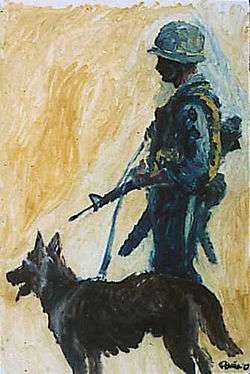 SCOUT DOG by Augustine G. Acuna, CAT II, 1966–67
SCOUT DOG by Augustine G. Acuna, CAT II, 1966–67 BODY COUNT by Alexander A. Bogdanovich, CAT II, 1966–67
BODY COUNT by Alexander A. Bogdanovich, CAT II, 1966–67 SKETCH OF SOLDIER II by Theodore E. Drendel, CAT II, 1966–67
SKETCH OF SOLDIER II by Theodore E. Drendel, CAT II, 1966–67 RECONNAISSANCE PATROL NEAR SOUTH CHINA SEA by David M. Lavender, CAT II, 1966–67
RECONNAISSANCE PATROL NEAR SOUTH CHINA SEA by David M. Lavender, CAT II, 1966–67 SECOND PLATOON ASSAULT by Gary W. Porter, CAT II, 1966–67
SECOND PLATOON ASSAULT by Gary W. Porter, CAT II, 1966–67
CAT III 16 February 1967 to 17 June 1967
 MONTAGNARD NEAR PLEIDJERONG I by Michael R. Crook, CAT III, 1967
MONTAGNARD NEAR PLEIDJERONG I by Michael R. Crook, CAT III, 1967 MED CAP by Dennis O. McGee, CAT III, 1967
MED CAP by Dennis O. McGee, CAT III, 1967 PERIMETER OF ARTY PASS AT BEAR CAT by Robert T. Myers, CAT III, 1967
PERIMETER OF ARTY PASS AT BEAR CAT by Robert T. Myers, CAT III, 1967 THE INNOCENT by Kenneth J. Scowcroft, CAT III, 1967
THE INNOCENT by Kenneth J. Scowcroft, CAT III, 1967 AFTER THE BATTLE by Stephen H. Sheldon CAT III 1967
AFTER THE BATTLE by Stephen H. Sheldon CAT III 1967 CHAPLAIN MARTINS BIBLE Stephen H. Sheldon, CAT III, 1967
CHAPLAIN MARTINS BIBLE Stephen H. Sheldon, CAT III, 1967
CAT IV 15 August to 31 December 1967
 GI CONVOY-EASY TOUCH by Samuel E. Alexander, CAT IV, 1967
GI CONVOY-EASY TOUCH by Samuel E. Alexander, CAT IV, 1967 AMERICAN DOCTOR EXAMINES VIETNAMESE CHILD by Samuel E. Alexander, CAT IV, 1967
AMERICAN DOCTOR EXAMINES VIETNAMESE CHILD by Samuel E. Alexander, CAT IV, 1967 RECONNAISSANCE, LONG BINH by Daniel T. Lopez, CAT IV, 1967
RECONNAISSANCE, LONG BINH by Daniel T. Lopez, CAT IV, 1967 CHARLIE SUBDUED by Burdell Moody, CAT IV, 1967
CHARLIE SUBDUED by Burdell Moody, CAT IV, 1967 KILLED IN ACTION by Burdell Moody, CAT IV, 1967
KILLED IN ACTION by Burdell Moody, CAT IV, 1967 NIGHT OPERATION by Burdell Moody, CAT IV, 1967
NIGHT OPERATION by Burdell Moody, CAT IV, 1967 BIG AND LITTLE FIREPOWER by Burdell Moody, CAT IV, 1967
BIG AND LITTLE FIREPOWER by Burdell Moody, CAT IV, 1967 LOOKING DOWN THE TRAIL, Watercolor, by James Pollock, CAT IV, 1967
LOOKING DOWN THE TRAIL, Watercolor, by James Pollock, CAT IV, 1967 DOOR GUNNER, Pen and Ink, by James Pollock, CAT IV, 1967
DOOR GUNNER, Pen and Ink, by James Pollock, CAT IV, 1967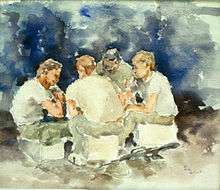 GI CARD GAME, Watercolor, by James Pollock, CAT IV, 1967
GI CARD GAME, Watercolor, by James Pollock, CAT IV, 1967 LONESOME, Mixed Media, by James Pollock, CAT IV, 1967
LONESOME, Mixed Media, by James Pollock, CAT IV, 1967 WAITING INTERROGATION,199th LT INF BG, Watercolor, by James Pollock, CAT IV, 1967
WAITING INTERROGATION,199th LT INF BG, Watercolor, by James Pollock, CAT IV, 1967 WAITING TO LIFT OFF, Ink/Watercolor Wash, by James Pollock, CAT IV, 1967
WAITING TO LIFT OFF, Ink/Watercolor Wash, by James Pollock, CAT IV, 1967 MED EVACUATION (93rd EVACUATION), Oil, by James Pollock, CAT IV, 1967
MED EVACUATION (93rd EVACUATION), Oil, by James Pollock, CAT IV, 1967 FIELD HAIRCUT AT BIG RED ONE, Ink/Watercolor wash, by James Pollock, CAT IV, 1967
FIELD HAIRCUT AT BIG RED ONE, Ink/Watercolor wash, by James Pollock, CAT IV, 1967 LOCALS, Oil, by James Pollock, CAT IV, 1967
LOCALS, Oil, by James Pollock, CAT IV, 1967 199th SOLDIERS WAIT, Gouache, by James Pollock, CAT IV, 1967
199th SOLDIERS WAIT, Gouache, by James Pollock, CAT IV, 1967 OLD VIETNAMESE MAN, Ink Wash, by James Pollock, CAT IV, 1967
OLD VIETNAMESE MAN, Ink Wash, by James Pollock, CAT IV, 1967 BACK FROM PATROL, Oil, by James Pollock, CAT IV, 1967
BACK FROM PATROL, Oil, by James Pollock, CAT IV, 1967 TAKING A BREAK, Oil, by James Pollock, CAT IV, 1967
TAKING A BREAK, Oil, by James Pollock, CAT IV, 1967 AIR CONTROLLER 196th LIB, Pen and Ink, by James Pollock, CAT IV, 1967
AIR CONTROLLER 196th LIB, Pen and Ink, by James Pollock, CAT IV, 1967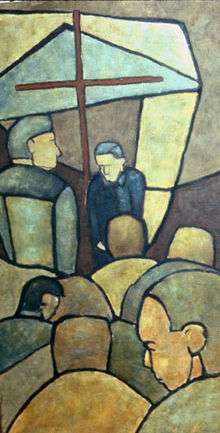 FIELD SERVICE, Oil (unfinished), by James Pollock, CAT IV, 1967
FIELD SERVICE, Oil (unfinished), by James Pollock, CAT IV, 1967 UNREAL REALITIES by Ronald A. Wilson, CAT IV, 1967
UNREAL REALITIES by Ronald A. Wilson, CAT IV, 1967 LOADED DOWN by Ronald A. Wilson, CAT IV, 1967
LOADED DOWN by Ronald A. Wilson, CAT IV, 1967 MORTAR ATTACK, COUNTERFIRE, Ronald A. Wilson, CAT IV, 1967
MORTAR ATTACK, COUNTERFIRE, Ronald A. Wilson, CAT IV, 1967
CAT V 1 November 1967 to 15 March 1968
 LISTENING by Warren W. Buchanan, CAT V, 1967–68
LISTENING by Warren W. Buchanan, CAT V, 1967–68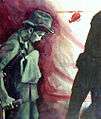 HURT by Philip V. Garner, CAT V, 1967–68
HURT by Philip V. Garner, CAT V, 1967–68 LAST STAND by Phillip W. Jones, CAT V, 1967–68
LAST STAND by Phillip W. Jones, CAT V, 1967–68 THE ENEMY? by Don R. Schol, CAT V, 1967–68
THE ENEMY? by Don R. Schol, CAT V, 1967–68 3 WAR MAN by John R. Strong, CAT V, 1967–68
3 WAR MAN by John R. Strong, CAT V, 1967–68
CAT VI 1 February 1968 to 15 June 1968
 5th SPECIAL FORCES PATROL by Robert T. Coleman, CAT VI, 1968
5th SPECIAL FORCES PATROL by Robert T. Coleman, CAT VI, 1968 SEARCH FOR AMMO CACHE (11th CAV) by Robert T. Coleman, CAT VI, 1968
SEARCH FOR AMMO CACHE (11th CAV) by Robert T. Coleman, CAT VI, 1968 TROOP COMMAND POST by Robert T. Coleman, CAT VI, 1968
TROOP COMMAND POST by Robert T. Coleman, CAT VI, 1968 TIME OUT by David N. Fairrington, CAT VI, 1968
TIME OUT by David N. Fairrington, CAT VI, 1968 LONG BINH by David N. Fairrington, CAT VI, 1968
LONG BINH by David N. Fairrington, CAT VI, 1968 IN THE FIELD by David N. Fairrington, CAT VI, 1968
IN THE FIELD by David N. Fairrington, CAT VI, 1968 NAVY'S BEST by David N. Fairrington, CAT VI, 1968
NAVY'S BEST by David N. Fairrington, CAT VI, 1968 WAITING by David N. Fairrington, CAT VI, 1968
WAITING by David N. Fairrington, CAT VI, 1968 YOUNG GIRLS by David N. Fairrington, CAT VI, 1968
YOUNG GIRLS by David N. Fairrington, CAT VI, 1968 BIG GUNS by David N. Fairrington, CAT VI, 1968
BIG GUNS by David N. Fairrington, CAT VI, 1968 THE LADIES by David N. Fairrington, CAT VI, 1968
THE LADIES by David N. Fairrington, CAT VI, 1968 YEA VIETNAM by David N. Fairrington, CAT VI, 1968
YEA VIETNAM by David N. Fairrington, CAT VI, 1968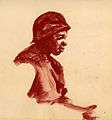 CAVALRY TROOPER by John D. Kurtz IV, CAT VI, 1968
CAVALRY TROOPER by John D. Kurtz IV, CAT VI, 1968 CHOPPERS by John D. Kurtz IV, CAT VI, 1968
CHOPPERS by John D. Kurtz IV, CAT VI, 1968 UNTITLED by Kenneth T. McDaniel, CAT VI, 1968
UNTITLED by Kenneth T. McDaniel, CAT VI, 1968 POTABLE WATER by Michael P. Pala, CAT VI, 1968
POTABLE WATER by Michael P. Pala, CAT VI, 1968
CAT VII 15 August 1968 to 31 December 1968
 CHOPPER PICK-UP by Brian H. Clark, CAT VII, 1968
CHOPPER PICK-UP by Brian H. Clark, CAT VII, 1968 SOLDIER RESTING by William E. Flaherty Jr., CAT VII, 1968
SOLDIER RESTING by William E. Flaherty Jr., CAT VII, 1968 S & D MISSION by William E. Flaherty Jr., CAT VII, 1968
S & D MISSION by William E. Flaherty Jr., CAT VII, 1968 APC-RPG-1 by William C. Harrington, CAT VII, 1968
APC-RPG-1 by William C. Harrington, CAT VII, 1968 MEDCAP by Barry W. Johnston, CAT VII, 1968
MEDCAP by Barry W. Johnston, CAT VII, 1968 500 METERS TO THE FRONT by Barry W. Johnston, CAT VII, 1968
500 METERS TO THE FRONT by Barry W. Johnston, CAT VII, 1968 FIREFIGHT by Stephen H. Randall, CAT VII, 1968
FIREFIGHT by Stephen H. Randall, CAT VII, 1968 LETTER TO HOME by Stephen H. Randall, CAT VII, 1968
LETTER TO HOME by Stephen H. Randall, CAT VII, 1968- COBRA by Stephen H. Randall, CAT VII, 1968
- HARD LABOR by Stephen H. Randall, CAT VII, 1968
 FLAMER by Stephen H. Randall, CAT VII, 1968
FLAMER by Stephen H. Randall, CAT VII, 1968- GET THEM OUT by Stephen H. Randall, CAT VII, 1968
- I SEE IT by Stephen H. Randall, CAT VII, 1968
- SOLDIERS by Stephen H. Randall, CAT VII, 1968
 TANK by Stephen H. Randall, CAT VII, 1968
TANK by Stephen H. Randall, CAT VII, 1968- SILENT SWEAT by Stephen H. Randall, CAT VII, 1968
- OVER THERE by Stephen H. Randall, CAT VII, 1968
 FIGURE STUDY by Stephen H. Randall, CAT VII, 1968
FIGURE STUDY by Stephen H. Randall, CAT VII, 1968 EARLY MORNING by Stephen H. Randall, CAT VII, 1968
EARLY MORNING by Stephen H. Randall, CAT VII, 1968 DOCK OF THE BAY by Stephen H. Randall, CAT VII, 1968
DOCK OF THE BAY by Stephen H. Randall, CAT VII, 1968 COMMUNICATION by Stephen H. Randall, CAT VII, 1968
COMMUNICATION by Stephen H. Randall, CAT VII, 1968- MOUNTAIN CLIMBER by Stephen H. Randall, CAT VII, 1968
CAT VIII 1 February 1969 to 15 June 1969
 CAMP IN AMERICAN DIVISION by Edward J. Bowen, CAT VIII, 1969
CAMP IN AMERICAN DIVISION by Edward J. Bowen, CAT VIII, 1969 SATURDAY UPTOWN by James R. Drake, CAT VIII, 1969
SATURDAY UPTOWN by James R. Drake, CAT VIII, 1969 LONG RANGE PATROL by James R. Drake, CAT VIII, 1969
LONG RANGE PATROL by James R. Drake, CAT VIII, 1969 BODY COUNT No. 5 by Roman Rakowskky, CAT VIII, 1969
BODY COUNT No. 5 by Roman Rakowskky, CAT VIII, 1969 PRISONER BLINDFOLDED by Roman Rakowsky, CAT VIII, 1969
PRISONER BLINDFOLDED by Roman Rakowsky, CAT VIII, 1969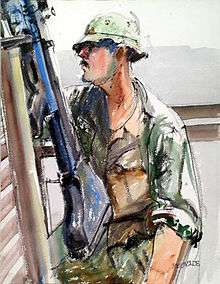 COMBAT ENGINEER by Victory V. Reynolds, CAT VIII, 1969
COMBAT ENGINEER by Victory V. Reynolds, CAT VIII, 1969 BRIDGE BUNKER WITH GUARD by Thomas B. Schubert, CAT VIII, 1969
BRIDGE BUNKER WITH GUARD by Thomas B. Schubert, CAT VIII, 1969 DAN TIENG OBSERVATION TOWER by Thomas B. Schubert, CAT VIII, 1969
DAN TIENG OBSERVATION TOWER by Thomas B. Schubert, CAT VIII, 1969
CAT IX 1 September 1969 to 14 January 1970
 APC by David E. Graves, CAT IX, 1969–70
APC by David E. Graves, CAT IX, 1969–70 RICE PADDY by James S. Hardy, CAT IX, 1969–70
RICE PADDY by James S. Hardy, CAT IX, 1969–70 RICE MILL, MY THO by William R. Hoettels, CAT IX, 1969–70
RICE MILL, MY THO by William R. Hoettels, CAT IX, 1969–70 GROUND GUIDE by Bruce N. Rigby, CAT IX, 1969–70
GROUND GUIDE by Bruce N. Rigby, CAT IX, 1969–70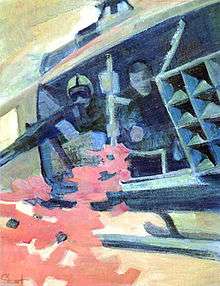 CHIEU HOI MISSION by Craig L. Stewart, CAT IX, 1969–70
CHIEU HOI MISSION by Craig L. Stewart, CAT IX, 1969–70
References
- 1 2 "Portrait of an Army" General Gordon R. Sullivan, Editor; Marylou Gjernes, Art Editor. (Center of Military History, United States Army, Washington, D.C. 1991), pp. 177-179.
- 1 2 McNaughton, Marian R. Telephone Interview with James Pollock 10 August 2003. (During the Vietnam War era McNaughton was Curator of Paintings, Army Art Collection, Office Chief of Military History).
- 1 2 3 "Announcement of US Army Vietnam Combat Artist Program for FY 1968 including overview and application instructions", U.S. Army CIRCULAR No. 28-30,(Publication from Headquarters Department of the Army, Washington, D.C., 20 July 1967).
- ↑ "US Army Vietnam Combat Artist Program Fact Sheet Dated 15 July 1967." U.S. Army Official Publication, (Prepared by United States Army in the Republic of Vietnam (USARV) Command Historian 15 July 1967).
- 1 2 "United States Army Vietnam Combat Art Program", James Pollock, (2003 Lecture), (Presentation given at U. S. Library of Congress, Mary Pickford Theater, Tuesday, 15 July 2003, Presentation Sponsor, Library of Congress Professional Association (LCPA) Veterans Forum, Washington, D.C.). CD of presentation in PDF format and can be found in U.S. Library of Congress Archives. Presentation was also videotaped and in LOC archives.
- ↑ "Army Combat Artist Program. Soldier Art From Vietnam Presented by the Department of the Army." U. S. Department of the Army Pamphlet,(Pamphlet distributed by The Adjutant General, Department of the Army, Washington, D.C. 1969.
- 1 2 3 "U. S. Army Soldier Artists in Vietnam," James Pollock,"War, Literature & the Arts", An International Journal of the Humanities, (Volume 21, 2009, ISSN 1046-6967 Published by the Department of English and Fine Arts, United States Air Force Academy, Colorado Springs, Colorado), pp. 247-272. (in public domain) essay: artwork:
- ↑ "Pictures Tell Story of U.S. Army Combat Art Program," Sarah Rouse, (Library of Congress THE GAZETTE, a Weekly Newspaper for the Library Staff, Volume 14, No 30, 5 September 2003 ISSN 1049-8184, James Madison Memorial Building LM5, Library of Congress, Washington, D.C.) p. 11.
- ↑ "Art of the American Soldier". National Constitution Center. Retrieved 29 June 2010.
External links
- Artwork from the Art Program at the United States Army Center of Military History webpage
- Humanities Magazine September/October 2011: Volume 32, Number 5
- About light and dark in peace and war and a piece of Vietnam Capital Journal (South Dakota), 17 January 2014.